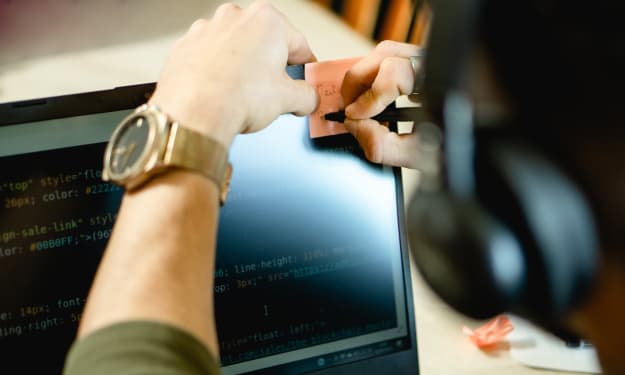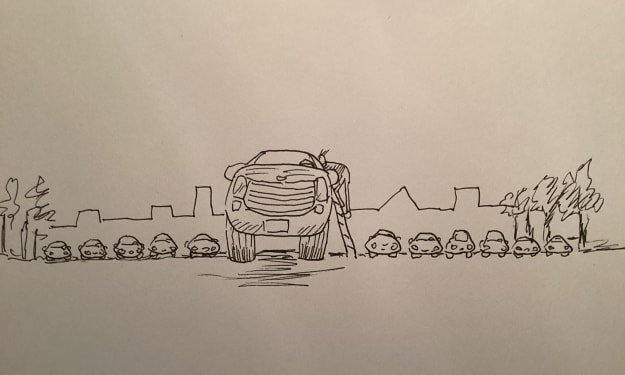Blazon Your Way to Brilliant Writing
A lesson in writing creative character descriptions

In Elmore Leonard’s Rules for Writing, he tells us to avoid detailed descriptions of characters. He cites Ernest Hemingway’s Hills Like White Elephants and asks what the American girl looks like.
“She had taken off her hat and put it on the table.”
That’s the only reference to her physical description. Hemingway doesn’t want to intrude on the reader or impede the story.
It’s a modern phenomenon.
- Cut the crap.
- Tell us the story.
- We ain’t got time for this.
But that isn’t entirely true.
There is most definitely an appetite to be wooed by the writer. There is a hunger to be charmed and mollycoddled. There is a desire to be uplifted and carried off.
Who wants to walk when you can travel first class?
The Blazon
A blazon is a coat of arms; a heraldic shield, emblem, or banner. Each of these is a showy display trumpeting its presence. We also use blazons in a sensational manner in the news, advertising or just to draw attention.
Blazons are prominent and visual.
In literature, writers use the blazon as a device to describe meticulously the attributes and physical features of a person, often focusing on their beauty or capturing the essence of the subject through intricate details.
Through blazons, writers construct a vivid picture of the character being described, which can include sights, sounds, smells, and feelings. Often, a blazon is used to idealise or objectify the person being described.
Rather than the reader imagining the character, creative writers use this literary device to enable readers to see the character they pictured.
Example blazons
Shakespeare fervently used blazons describing his characters using similes, metaphors and hyperbole. They may appear to some as staid, ancient, past it, out of vogue.
Detailed lead-ins and expressive character depictions are the backbone in the writings of Jane Austin, Emily Dickinson and Thomas Hardy.
Yet, contemporary authors like Bonnie Garmus and Frieda McFadden are modernising the blazon. They are using aspects of the blazon to detail their characters and craft compelling character images that bring their creations to life.
“Walter could only stare. Tall and angular, with hair the color of burnt buttered toast pulled back and secured with a pencil, she stood hands on hips, her lips unapologetically red, her skin luminous, her nose straight. She looked down at him like a battlefield medic assessing whether or not he was worth saving.”
— Bonnie Garmus, Lessons in Chemistry
“ Mrs. Winchester tucks a strand of shiny, golden-blond hair behind her ear. Her hair is chin-length, cut into a fashionable bob that de-emphasizes her double chin. She is in her late thirties and with a different hairstyle and different clothing, she would be very ordinary-looking. But she has used her considerable wealth to make the most of what she has got. I can’t say I don’t respect that.”
— Frieda McFadden, The Housemaid
There is a place for them.
I’ve been working on a story that expands the blazon. Here I set up the punchline with a little-known psychological phenomenon about bonding. Then I detail the workings of the iris sphincter muscle (this is the first blazon).
Then I use a contemporary blazon to describe the love of my life and the final blazon is self-reflective. Here I go, I hope you like it —
Why I drink
When a baby is born, the way it learns the emotions its mother is feeling starts with eye contact. At first, they can hardly see anything. As they focus, they understand more about their mother’s expressions.
Most people are right-handed. That means when a mother holds her baby, she most often uses her left arm, leaving her stronger arm for all the tasks she needs to do. When she gazes at her baby, her right eye looks into its left eye. That interaction from the optic nerve is going around the brain and impacting the amygdala — the part of the brain where emotions come from.
This creates a bonding loop between the baby and the mother. This continues into adulthood and makes the right-eye-to-left-eye connection the most bonding contact you can have with another person.
Since left-handed people represent only 13% of the population, and most are ambidextrous, if you are a gambling lothario, you’d opt to sit to the right of your beau. When you turn to face each other, your right eye looks directly into their left.
Looking into someone’s left eye releases more of the body’s bonding hormone, oxytocin, so you are more likely to trust the person. Trust is the precursor to love.
Encircling the pupil in your eye are the circular fibres of the pupillary constrictor muscle. It constricts the pupil to reduce the light reaching the retina or enlarge it depending on the environment. The iris muscle is part of your sympathetic nervous system.
Other than a chemical imbalance, the iris muscle is only activated by the external environment. You cannot manipulate it like your tongue. It only responds to dangerous or stressful situations.
But there is one more occasion when your pupil expands to flood your visual senses. This happened when I met Alison MacPherson.
Alison MacPherson floated into the school canteen, searching for the safety of an empty table. She was alone, chewing on her lip with teeth that were straight and white. The tight fit of her uniform accentuated her athletic figure.
Her black hair glistened like wet coal. She swept a lock from her eyes, revealing more of her flawless olive-gold skin, her nose ever so slightly turned up, lips pouty from her nervous chewing.
Alison stood for a second to adjust the bag over her left shoulder before gliding to the least busy table — mine. She sat two seats to my right and took a second before looking up. Alison MacPherson looked into my eyes and sent my circus of iris muscles dancing.
Alison’s olive-gold cheeks flushed, but she didn’t turn away. Our eyes remained connected by an invisible force. Her pupils expanded as round and as big as a moonlit pool, the sea. An ocean. At that moment, I was smitten. I knew I’d love this girl until the sun devoured the moon. Until the end of the universe.
We spoke. She, between chewing on small bites of her lunch box sandwich, me between mouthfuls of spaghetti bolognese. She was new to the school. Uplifted from her childhood home by the coast. Removed from her friends, her clubs and comforts. It ended her happy life by the sand and the sea seventy miles away.
“To this place,” she said.
I resolved to become her coast. “Alison,” I smiled, “would you like to go on a date?”
She stared into my eyes for a moment. Not long. But long enough for me to feel the steeliness. “Not if you were the last person on earth,” she said.
It was years later that I learned of the right-eye-left-eye mother/baby bonding. This information brought solace to my battered pride with the conclusion that Alison MacPherson’s mother was indefatigably and tirelessly left-handed.
A roll of the silver ball led Alison MacPherson to sit on the wrong side of me at that school canteen table, and a simple genetic trait sealed my fate. Poor me.
I often think back to that sorry, luckless, schoolboy. Marked by misfortune — like his sauce-spattered shirt. Ill-fated, hapless, wronged. Downcast by rejection and forever wary of future cold shoulders, especially the perfect smooth-skinned elegant variety with cascading vibrant dark tresses.
That sad little boy, resigned never to experience the intense love of Aphrodite. The boy who grew to love only wine and the astonishment of its release.
Malky McEwan
Writing with Eloquence
About the Creator
Malky McEwan
Curious mind. Author of three funny memoirs. Top writer on Quora and Medium x 9. Writing to entertain, and inform. Goal: become the oldest person in the world (breaking my record every day).
Enjoyed the story? Support the Creator.
Subscribe for free to receive all their stories in your feed. You could also pledge your support or give them a one-off tip, letting them know you appreciate their work.







Comments (4)
Excellently written. It's true, your style is eloquent.
Very informative and wonderfully written. Thank you.
Love it. I definitely use blazon styles in my writing with my characters
Wondrous job! Keep up the exceptional effort—congrats!